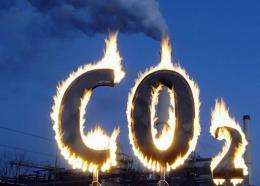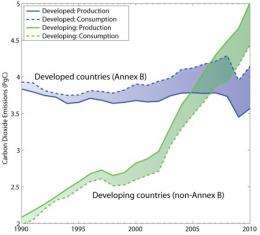Fossil-fuel emissions unbraked by financial crisis

Emissions of carbon dioxide (CO2) from fossil fuels and the cement industry scaled a record high in 2010, rocketing by 5.9 percent over 2009 in a surge led by developing countries, scientists reported on Sunday.
For the first time ever, annual CO2 from these sources topped nine billion tonnes, reaching an estimated 9.1 gigatonnes, they said in a letter to the journal Nature Climate Change.
The year-on-year rise was the highest ever recorded and more than wiped out a 1.4-percent fall in 2009 which occurred as a result of the 2008 global financial crisis.
"After only one year, the global financial crisis has had little impact on the strong growth trend of global CO2 emissions that characterised most of the 2000s," said the letter, led by Glen Peters of the Center for International Climate and Environmental Research in Norway.
The rebound may be explained by a swift easing in energy prices and injections of government funds to help recovery, the authors suggested.

CO2 emissions from rich countries fell by 1.3 percent in 2008 and 7.6 percent in 2009, but increased by 3.4 percent in 2010. The United States, historically the world's biggest emitter and currently ranked second after China, saw an increase in 2010 of 4.1 percent.
Even so, emissions from developed countries in 2010 remained lower than their average emissions when measured over 2000-2007.
In contrast, emissions from developing countries increased by 4.4 percent in 2008, 3.9 percent in 2009 and 7.6 percent in 2010.
This growth was concentrated especially in China, which saw a year-on-year increase of 10.4 percent, and in India, where there was a rise of 9.4 per cent.
The letter, authored by six prominent scientists, was published at the midway point at the UN climate talks in Durban, South Africa.
Nations are struggling for agreement on how to tame CO2 and other "greenhouse" gases which trap solar heat and thus create a man-made trigger for climate change.
One of the biggest bones of contention is whether emerging giant economies should be part of a global, legally-binding treaty.
The United States says a pact can only be envisaged if China and India, in particular, have constraints.
Right now, the developing countries have no specific curbs under the Kyoto Protocol or under the wider agreement in the UN's Framework Convention on Climate Change (UNFCCC).
The letter published on Sunday concurs with data published last month by the US Department of Energy that focused on fossil-fuel consumption.
According to an analysis on Thursday released by a British risk-analysis firm Maplecroft, five countries -- China, the United States, India, Russia and Japan -- account for more than half of all emissions of man-made greenhouse gases.
Brazil, Germany, Canada, Mexico and Iran lie just behind.
More information: DOI: 10.1038/nclimate1332
(c) 2011 AFP

















